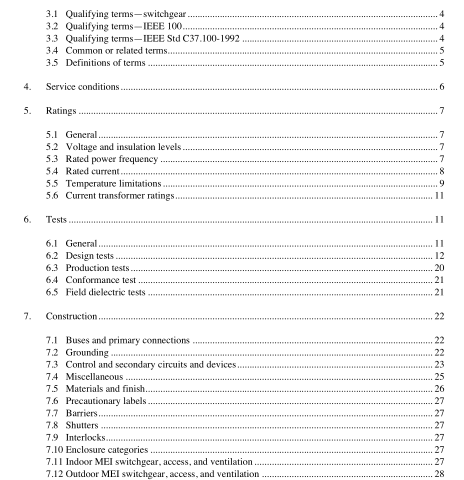IEEE C37.20.3-2001 pdf download.IEEE Standard for Metal-Enclosed Interrupter Switchgear
Definitions
The definitions of terms contained in this standard, or in other standards referred to in this standard are not intended to embrace all legitimate meanings of the terms. They are applicable only to the subject treated in this standard.
If a term is not defined in this standard, the definition in IEEE Std C37.100-1992 applies. An asterisk (*) fol- lowing a definition indicates that the definition in this standard is not contained in IEEE Std C37.100-1992 while a dagger (†) indicates the definition differs from that in IEEE Std C37.100-1992.
3.1 Qualifying terms—switchgear
3.1.1 switchgear: A general term covering switching and interrupting devices and their combination with associated control, instrumentation, metering, protective, and regulating devices and covering assemblies of these devices with associated interconnections, accessories, and supporting structures used primarily in con- nection with the generation, transmission, distribution, and conversion of electrical power.
3.1.2 switchgear assembly (see Figure A in the introduction) : An assembled equipment (indoor or outdoor) including, but not limited to, one or more of switching, interrupting, control, instrumentation, metering, pro- tective, and regulating devices, together with their supporting structures, enclosures, conductors, electric interconnections, and accessories.
3.1.3 metal-enclosed power switchgear: A switchgear assembly completely enclosed on all sides and top with sheet metal (except for ventilating openings and inspection windows) containing primary power circuit switching or interrupting devices, or both, with buses and connections and possibly including control and auxiliary devices. Access to the interior of the enclosure is provided by doors or removable covers.
3.1.4 metal-enclosed interrupter (MEI) switchgear: Metal-enclosed power switchgear including the fol lowing equipment as required:
a) Interrupter switches
b) Power fuses (current-limiting or noncurrent-limiting)
c) Bare bus and connections
d) Instrument transformers
e) Control wiring and accessory devices
The interrupter switches and power fuses may be stationary or removable (drawout). When removable, auto matic shutters (that cover primary circuit elements when the removable element is in the disconnected, test, r removed position) and mechanical interlocks shall be provided for proper operating sequence.
3.2 Qualifying terms
IEEE 100 The following qualifying terms are defined in The Authoritative Dictionary of IEEE Standards Terms, ev- enth Edition; and the user is referred to the definitions (relating to types of enclosures, ventilation ethods, etc.) given in that dictionary:
3.2.1 accessible
3.2.2 enclosed
3.2.3 isolated
3.2.4 ventilated
3.3 Qualifying terms—IEEE Std C37.100-1992
The following qualifying terms are defined in IEEE Std C37.100-1992, and the user is referred to the definitions given in that dictionary:
3.3.1 enclosure
3.3.2 lame-resistant (retardant)
3.3.3 indoor
3.3.4 metal-enclosed
3.3.5 outdoor
3.3.6 resistant (suffix)
3.3.7 secondary
3.3.8 ventilated enclosure
3.4 Common or related terms
The following common or related terms are defined in IEEE Std C37.100-1992, and the user is referred to
the definitions given in that dictionary:
3.4.1 asymmetrical
3.4.2 auxiliary switch
3.4.3 bus
3.4.4 connected position
3.4.5 continuous current tests
3.4.6 disconnected position
3.4.7 drawout-mounted device
3.4.8 ground bus
3.4.9 main (primary switchgear connections)
3.4.10 normal frequency
3.4.11 primary disconnecting devices
3.4.12 removable element
3.4.13 secondary and control wiring
3.4.14 silver surfaced
3.4.15 stationary mounted device
3.4.16 symmetrical
3.4.17 terminal
3.4.18 terminal block
3.4.19 test position
3.5 Definitions of terms
3.5.1 ambient air temperature:
The temperature of the surrounding air that comes in contact with
equipment.*
NOTE—Ambient air temperature, as applied to enclosed switchgear assemblies, is the average temperature of the sur-
rounding air that comes in contact with the enclosure. See 6.2.2.3 for method of measurement.IEEE C37.20.3 pdf download.IEEE C37.20.3-2001 pdf download
IEEE C37.20.3-2001 pdf download

Leave a Reply